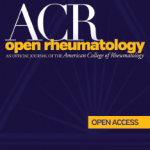Patricia P. Katz, PhD, and Edward H. Yelin, PhD, both professors of medicine (rheumatology) and health policy at the University of California, San Francisco School of Medicine, took the journal to a whole new level, according to those involved with the CJP. Dr. Yelin remarks, “The journal has had a history of really great editors. These were energetic people who faced greater challenges than we did. They set the stage so that when there was a confluence of the shared impact factor, the growth of clinical research, and internationalization of research, that allowed things to take off.”
Dr. Katz agrees with her colleague: “We were fortunate to come along at the right time and to be able to stand on those historical shoulders.” During their tenure, Drs. Katz and Yelin took advantage of their extensive professional network within the ACR and ARHP and introduced special-themed issues, providing a single forum for exploring multidisciplinary work on specific issues affecting people with rheumatic conditions. During Drs. Katz and Yelin’s editorship, AC&R, along with A&R, instituted several new policies, including registration of clinical trials, international institutional review board approval of studies with human subjects, and guidelines regarding authorship; added the “Policy Matters” and “Clinical Aspects of Molecular Research in Rheumatology” features; and guided the journal through the e-publication-ahead-of-print-issue gauntlet.
A Healthy Tension

Antony Rosen, MD, director of the division of rheumatology and professor of medicine, cell biology, and pathology at The Johns Hopkins University in Baltimore, served as chair of the CJP during the time that Drs. Katz and Yelin became co-editors. Inclusion of the journal with A&R had instantaneously and dramatically improved its impact factor. “That was the turnaround phase,” he recalls.
During the copublication period and since the separation of the two journals, collegiality has dominated the relationship between the two journals’ editors. Drs. Pisetsky and Hunder often alerted each other to submitted papers that would fit under the umbrella of the other journal’s content focus. Still, notes Dr. Rosen, “there has always been some tension about defining the scope of the two journals. There may be some papers that A&R believes belong in their journal and not in AC&R, and vice versa. But such is life, and a little competition is a healthy thing.” Dr. Pisetsky agrees, and believes that the ACR’s tent is big enough for both sister journals. “I think AC&R represents a very important area of scholarship. I’m delighted that it has a clear identity. And, although there may be overlap between the two journals, having AC&R allows A&R an even stronger involvement with more basic and translational research, since the combined journal represented a big increase in pages with ‘high impact’ and encouraged more submissions.”


